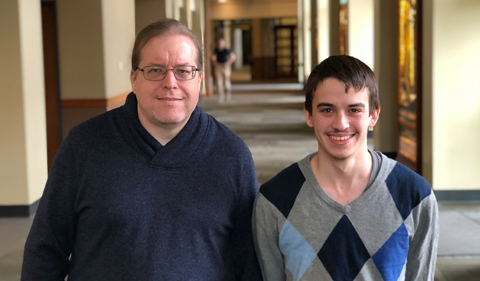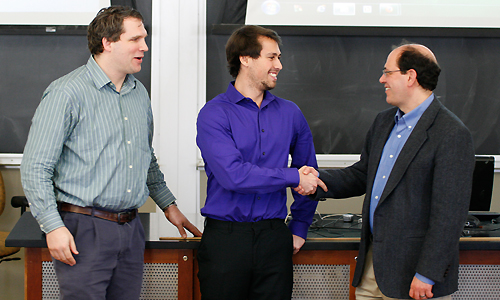Six Ohio University undergraduate Physics & Astronomy students presented an overview of their projects undertaken the previous summer, during the 2018 Society of Physics Students Research Conference held recently in Walter Hall. The presentations were reviewed by a panel of two faculty judges. Society of Physics (SPS) Faculty Adviser Dr. Gang Chen facilitated the morning’s program and judging.
First place winner Michael Jaramillo presented a 15-minute talk, ‘Using Weak Gravitational Lensing to Probe Dark Matter Distributions in Galaxy Clusters’. Jaramillo did summer research under the direction of Dr. Douglas Clowe, an astronomy professor in the Department.
“My project is on using weak gravitational lensing to examine dark matter distributions in galaxy clusters,” Jaramillo says. “Gravitational lensing causes the lensed object to be stretched tangentially (shear) around the lensing mass. By taking statistical measurements of many background galaxies’ ellipticities, removing bad objects (diffraction spikes, objects on the edge of the images, etc.), and looking for the preferred directions of shear, we can create a map of the weak gravitational lens. By comparing this lensing map to a light map of the cluster (distribution of baryonic matter), we can determine the distribution of the unseen matter (dark matter) needed to produce the weak lensing we observe.”
According to conventional cosmology models, Jaramillo explains, the universe is comprised of nearly 27% dark matter. It appears in many areas of astronomical research such as galaxy rotation, the Cosmic Microwave Background, and gravitational lensing. So in order to further understand the nature of the universe, astronomers need to learn more about the nature of dark matter.
“This topic is particularly fascinating to me because of how important dark matter is to many of the leading cosmological models. This study can help place constraints on various properties of dark matter, which in turn could lead to further discoveries. Doing work on the frontier of our astronomical understanding has always been a dream of mine and I’m very grateful to Ohio University and Dr. Clowe for allowing me to take part in such excited work!”
Two ‘Honorable Mention’ awards were given by the judges to Samuel Hanson and Anika Friedman.
Hanson presented, ‘Study of Quark Gluon Plasma at Brookhaven National Lab’s Relativistic Heavy Ion Collider’. He conducted summer research with Associate Professor Dr. Justin Frantz.
“My project is about the study of quark gluon plasma at Brookhaven National Lab’s Relativistic Heavy Ion Collider (RHIC), says Hanson. “It is important to study the nature of quarks, particles that make up protons and neutrons. I’m learning about the Strong Nuclear Force, one of the four fundamental forces. I wanted to work with one of the most impressive feats of science ever built: the RHIC at Brookhaven Labs.”
Friedman presented ‘Neurofilament Slowing’. She studies with Distinguished Professor of Physics Dr. Peter Jung.
“My project is about modeling neurofilament slowing in the axons of the rat sciatic nerve. This is important because defects in transport lead to neurolodegenerative diseases. I really like math and find neuroscience very interesting and using physics I can apply mathematics to neuroscience.”

Samuel Hanson (left) and Anika Friedman received Honorable Mention recognition from Physics and Astronomy Chair Dr. David Ingram, and judges Drs. David Tees and Paul King.
Other students who presented their research include Brandon Niese – ‘Correlation of cell cycle and DNA damage in pore migration’, Jack Bruno – ‘A Case Study of Data Collected During the Lake Michigan Ozone Study’, and Grant Merz – ‘Modeling the Nuclear Environment of Type 1 X-ray Bursts’.
The Ohio University Chapter of the Society of Physics Students (SPS) meets weekly during the academic year. SPS welcomes undergraduate students from all physics-related departments and majors, including astronomy, science education, engineering, and other sciences. Most meetings feature a guest speaker from the OHIO faculty or from another institution.




















Comments